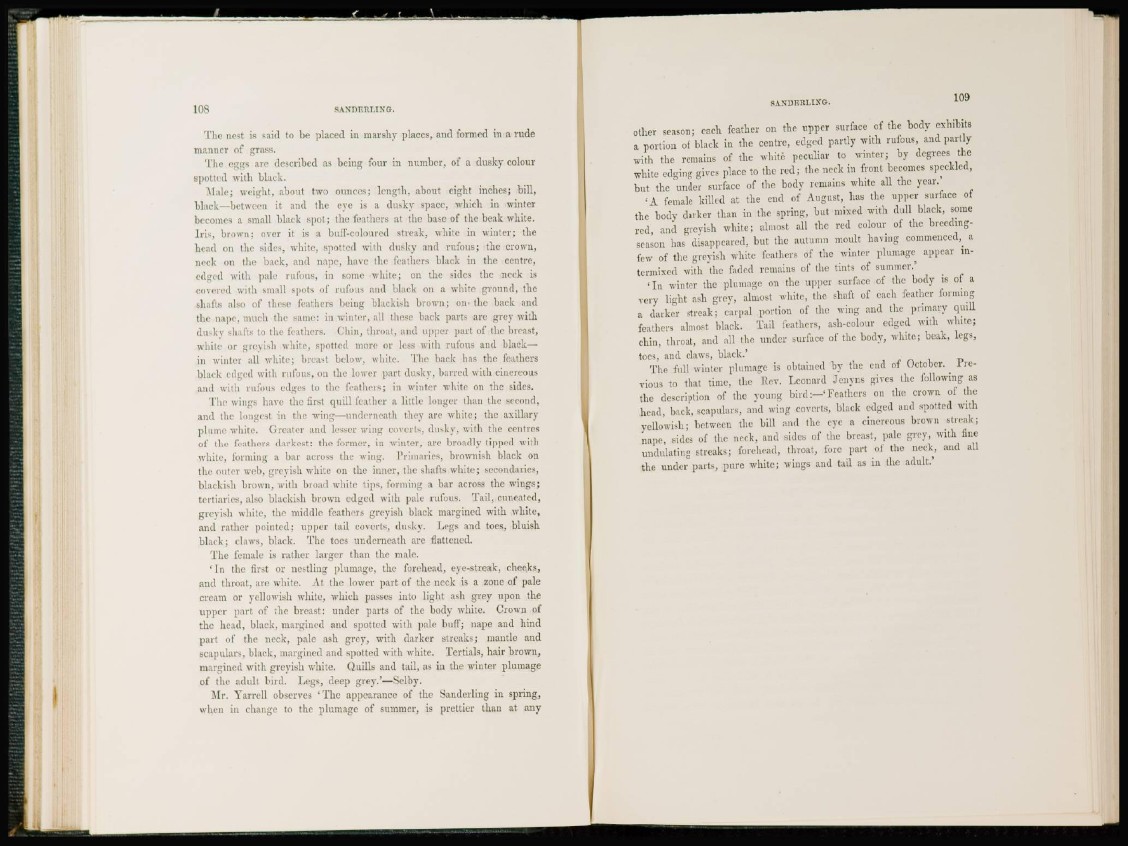
108 SANDERLING.
The nest is said to be placed in marshy places, and formed in a rude
manner of grass.
The eggs are described as being four in number, of a dusky colour
spotted with black.
Male; weight, about two ounces; length, about eight inches; bill,
black—between it and the eye is a dusky space, which in winter
feecojaes a small black spot; the feathers at the base of the beak white.
I r i s , brown; over it is a buff-coloured streak, white in winter; the
head on the sides, white, spotted with dusky and rufous; the crown,
neck on the back, and nape, have the feathers black in the centre,
edged with pale rufous, in some white; on the sides the neck is
covered with small spots of rufous and black on a white ground, the
shafts also of these feathers being blackish brown; on-the back and
the nape, much the same: in winter, all these back parts are grey with
dusky shafts to the feathers. Chin, throat, and upper part of the breast,
while or greyish uhiio, spotted more or less with rufous and b l a c k -
in winter all white; breast below, white. The back has the leathers
black edged with rufous, on the lower part dusky, barred with cinereous
and with rufous edges to the feathers; in winter white on the sides.
t h e wings have the first quill feather a little longer than the second,
and the longest in the wing—underneath they are white; the axillary
plume white. Greater and lesser wing coverts, dusky, with the centres
of the feathers darkest: the former, in winter, arc broadly tipped with
white, forming a bar across the wing. Primaries, brownish black on
the outer web, greyish white on the inner, the shafts white; secondaries,
blackish brown, with broad white tips, forming a bar across the wings;
tertiaries, also blackish brown edged -with pale rufous. Tail, cuneated,
greyish white, the middle feathers greyish black margined with white,
and rather pointed; upper tail coverts, dusky. Legs and toes, bluish
black; claws, black. The toes underneath arc flattened.
The female is rather larger than the male.
' I n the first or nestling plumage, the forehead, eye-streak, cheeks,
and throat, are white. At the lower part of the neck is a zone of pale
cream or yellowish white, which passes into light ash grey upon the
upper part of rhe breast: under parts of the body white. Crown of
the head, black, margined and spotted with pale buff; nape and hind
part of the neck, pale ash grey, with darker streaks; mantle and
scapulars, black, margined and spotted with white. Tertials, hair brown,
margined with greyish white. Quills and tail, as in the winter plumage
of the adult bird. Legs, deep grey.'—Selby.
Mr. Yarrcll observes ' T h e appearance of the Sanderling in spring,
when in change to the plumage of summer, is prettier than at any
other season; each feather on the upper surface of the body exhibits
a portion of black in the centre, edged partly with rufous, and partly
with the remains of the white peculiar to winter; by degrees the
white edging gives place to the red; the neck in front becomes speckled,
but the under surface of the body remains white all the year.'
' A female killed at the end of August, has the upper surface of
the body darker than in the spring, but mixed with dull black, some
red, and greyish white; almost all the red colour of the breedingseason
has disappeared, but the autumn moult having commenced, a
few of the greyish white feathers of the winter plumage appear intermixed
with the faded remains of the tints of summer.'
' I n winter the plumage on the upper surface of the body is of a
very light ash grey, almost white, the shaft of each feather forming
a darker streak; carpal portion of the wing and the primary quill
feathers almost black. Tail feathers, ash-colour edged with white;
chin, throat, and all the under surface of the body, white; beak, legs,
toes, and claws, black.*
The full winter plumage is obtained by the end of October. Previous
to that time, the Rev. Leonard Jenyns gives the following as
the description of the young bird:—'Feathers on the crown of the
head, back, scapulars, and wing coverts, black edged and spotted with
yellowish; between the bill and the eye a cinereous brown streak;
nape, sides of the neck, and sides of the breast, pale grey, with fine
undulating streaks; forehead, throat, fore part of the neck, and all
the under parts, pure white; wings and tail as in the adult.'